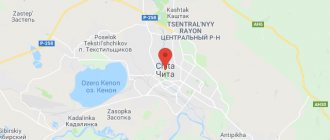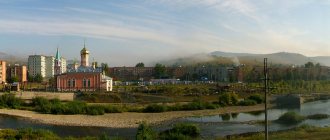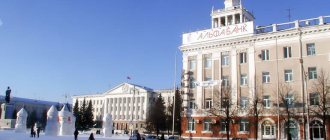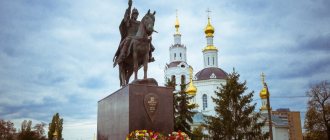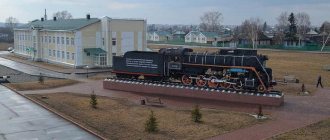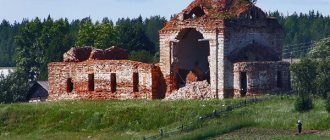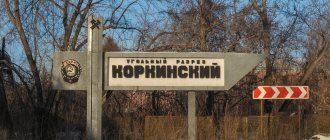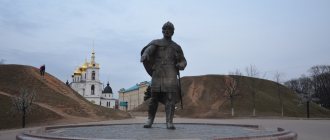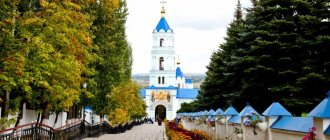For other places with the same name, see Inza.
City in Ulyanovsk region, Russia
| Inza Inza | |
| City [1] | |
| View of Inza | |
| Coat of arms | |
| Location of Inza | |
| Inza Location of Inza Show map of Russia Inza Inza (Ulyanovsk region) Show map of Ulyanovsk Oblast | |
| Coordinates: 53°51'N 46°21'E / 53.850°N 46.350°E / 53.850; 46.350 Coordinates: 53°51'N 46°21'E. / 53.850°N 46.350°E / 53.850; 46.350 | |
| A country | Russia |
| Federal subject | Ulyanovsk region [1] |
| Administrative region | Inzensky district [1] |
| City of district significance | Inza [1] |
| Based | 1897 |
| City status from | 1946 |
| Height | 170 m (560 ft) |
| population size (2010 Census) [2] | |
| • General | 18 803 |
| • Evaluate (2018) [3] | 17 630 ( -6,2% ) |
| Administrative status | |
| • Capital from | city of district significance Inza [1] |
| Municipal status | |
| • Municipal district | Inzensky municipal district [4] |
| • Urban village | Inzenskoe urban settlement [4] |
| • Capital from | Inzensky municipal district [4], urban settlement Inzenskoye [4] |
| Timezone | UTC+4 (UTC+04:00[5]) |
| Postal code [6] | 433030–433034, 433059 |
| OKTMO ID | 73610101001 |
Inza
(Russian: Inza) is a city and the administrative center of the Inzensky District in Ulyanovsk Oblast, Russia, located on the Syuksyumka River (Sura's basin) 167 km (104 mi) southwest of Ulyanovsk, the administrative center of the region. Population: 18,803 (2010 census); [2] 20,288 (2002 census); [7] 23,509 (1989 census).[8]
Links[edit]
Notes[edit]
- ^ abcdefg Law No. 126-ZO
- ^ a b Federal State Statistics Service (2011). “All-Russian Population Census 2010. Volume 1" [All-Russian Population Census 2010, vol. 1]. All-Russian Population Census 2010 [All-Russian Population Census 2010]
. Federal State Statistics Service. - "26. The size of the permanent population of the Russian Federation by municipalities as of January 1, 2022". Federal State Statistics Service. Retrieved January 23, 2022.
- ^ abcde Law No. 043-ZO
- "On the Calculation of Time". Official Internet portal of legal information
. June 3, 2011. Retrieved January 19, 2022. - Post office. Information and computing center of OASU RPO. ( Post office
).
Search for postal service objects ( postal Search for objects
) (in Russian) - ↑
Federal State Statistics Service of Russia (May 21, 2004).
“The population of Russia, the constituent entities of the Russian Federation as part of federal districts, urban settlements, settlements, settlements is 3 thousand or more people” [Population of Russia, its federal districts, federal districts, districts Urban settlements, rural settlements - administrative centers and rural settlements with a population of over 3,000] (XLS). All-Russian Population Census 2002
. - “All-Union Population Census of 1989. The current population of union and autonomous republics, autonomous regions and districts, territories, negative phenomena, urban settlements and rural district centers” [All-Union Population Census of 1989: current population of union and autonomous republics, Autonomous regions and districts , territories, regions, districts, urban settlements and villages performing the functions of district administrative centers. All-Union Population Census of 1989 [All-Union Population Census of 1989]
.
Institute of Demography of the National Research University: Higher School of Economics [Institute of Demography of the National Research University: Higher School of Economics]. 1989 - via Demoscope Weekly
.
Inza
origin of name
The name of the city Inza presumably comes from the Erzya word “inzeen” (crimson). According to a less popular version among scientists, “inza” comes from the Chuvash word “inze”, that is, “distant”. This is explained by the fact that the station was the outer station for some time and was located further than all the others. However, not all scientists support this version of origin. The station was indeed a last resort for some time. But the construction of the railway was carried out at a relatively fast pace. The name shouldn't have stuck.
The settlement of the territory of modern Inza began more than six thousand years ago. The first settlements appeared here in the Neolithic era. One of the sites was discovered near the place where the railway bridge is located today. Tools of ancient people (stone axe, scraper, harpoon, etc.) were found at the site. Other sites were also discovered, united by archaeologists into the Sur-Isen group.
Kitovka village
The history of Inza fits into just one century. The city's prehistory is much richer. It is impossible to consider the history of the city separately from those settlements that were located on the territory of modern Inza. The village of Kitovka, for example, has today become part of the city. Meanwhile, this is a very ancient settlement that cannot be ignored. There is not a single document that reliably tells about the appearance of Kitovka. There is a version that the settlement got its name from the name of its founder, Keith Voronin. Keith was a service man. About 300 years ago, Voronin, like many other service people of that time, received a land plot. Over time, a village appeared here, named after the owner of the land. According to other versions, the village belonged to disgraced nobles who were sent into exile in these parts. A certain Evsey Kitov is also mentioned, after whose last name the village was allegedly named. At the beginning of the 19th century, a stone church was erected in Kitovka. Many years later, a gatehouse was added to it, in which the local clerk taught children to read and write. And in the late 1870s the first teacher was sent here. At the beginning of the twentieth century, the gatehouse, which served as a school, burned down. Instead, a stone school appeared, which has survived to this day.
At the turn of the 19th – 20th centuries
The construction of the railway played a huge role in the development of Inza. A railway line was built here connecting Kazan and Moscow. The merchant class of Russia especially insisted on the construction of the railway. In an effort to enter the world market, merchants needed a new type of transport. It was impossible to transport goods to Europe on horseback, and rivers did not always flow in the direction desired by merchants. Construction of the Moscow-Kazan line began in 1866. By the end of 1893, construction was completed. The Simbirsk Zemstvo Assembly decided to submit a petition to connect Simbirsk with the railway line. Permission to join was received in 1895. The line was built in 1898. The local station was given the name Inza. The railway passed next to Kitovka. The station was a small wooden station building, behind which houses were built for the workers, the duty officer and the station manager. Gradually, those who had nothing to do with the railway began to build houses next to the employees’ houses.
In 1899, a post office appeared at the station. Inn and gendarmerie buildings were also built. Merchants Morozov and Khrapsky set up their shops in the station village. The school was built last. Before the advent of school, children were forced to receive education in Kitovka. The distance between the station and the village was considerable. It was especially difficult to get to school and back in severe frosts. At the beginning of the twentieth century, a sawmill appeared near the station village, owned by Butlerov. Then the sawmills of Paramonov and the Kita merchant Karpov appeared.
The city in the first half of the 20th century
After the end of the civil war, the inhabitants of the new country began to restore the economy damaged by the war. Inza was practically unaffected by destruction. Since there were no large industrial enterprises in the village, there was nothing to restore here. Real construction in Inza began only after the civil war. Railroad traffic gradually improved. A decision was made to expand the depot. The sawmill has resumed its work. The first club appeared in the village (named after V.I. Lenin). A steam power station was built on the banks of the Syuksyumka River. The energy of one power plant was not enough for the village. In 1925, a second power station appeared at the depot. In the late 1920s, construction of a diatomaceous earth plant began. In 1929, the Inzensky district was formed. It included 46 village councils. The station village becomes a regional center. The number of residents in Inza has increased several times.
Despite the fact that in the Inzensky district there were 12 enterprises by the beginning of the 30s, the area was considered predominantly agricultural. The enterprises employed about a thousand workers. In those years, handicraft production flourished in the Inzensky district. There were at least six thousand artisans here. They were engaged in the production of sleighs, carts and matting. Waste fishing was also popular. More than five thousand people left the area to work as carpenters, painters and masons. The slow pace of development of industrial enterprises in the region was due to a lack of energy resources. In 1932, a diesel power station was built at the railway. But its power was not enough, since it produced no more than 150 kilowatts.
By the mid-30s, there were about ninety collective farms and 3 MTS in the area. The largest MTS was located in Inza. She owned thirty tractors. In the 30s, there were already 16 industrial enterprises in the Inzensky district. They employed more than one and a half thousand workers. About three thousand artisans became members of industrial artels, the direction of which remained the same. The artels made sleighs, made hard and soft containers, and were engaged in woodworking. However, it was these artels that laid the foundation for modern industry in Inza.
During the war years
By the beginning of the 40s, Inza, despite the increasing pace of development, remained a small station village. Inza consisted of three streets stretching along the railway tracks. Between the village and the station there was a huge, unoccupied area. The plans of local authorities included extensive construction. The village was about to grow significantly. The implementation of the plans was interrupted by the war. 16 thousand residents of the Inzensky district went to the front. The old people, women and children who remained in Inza and surrounding settlements were supposed to replace the men who had gone to fight in their workplaces. The Inzensky region was supposed to supply the front with bread and timber, since the region was rich in these very resources. Understanding the need for forests and bread for the front, the residents of Inza created brigades of uninterrupted work.
During the war years, the population of Inza grew to 28 thousand due to the arrival of evacuees. One of the district's tasks was to accommodate and provide assistance to new arrivals, many of whom needed medical treatment. In Inza there were much fewer buildings suitable for people to live in than there are today. However, the residents of the village and region managed to cope with the task. All evacuees who arrived here received the necessary medical care, clothing, food and shelter. The situation, however, was complicated by the diphtheria epidemic that hit the area. The sick people needed not only treatment, but also rehabilitation. It was necessary to open special canteens for people weakened by illness.
Severe trials awaited railway workers during the Great Patriotic War. Inzen railway workers distinguished themselves with military valor and hard work even during the Civil War. Very often they had to work after hours, repairing armored trains for the Red Army. If the need arose, railway workers repelled enemy attacks with rifles in their hands. During the war of 1941-1945, the railway suffered from a shortage of workers. Most of the railway workers went to the front, and the rest had to work almost around the clock. There were often shortages of locomotives and repair parts. However, all this should not delay the movement of trains and prevent them from arriving at their destination on time.
More than half of the residents of the Inzensky district did not return from the front. Many returnees were unable to work. But this did not stop the residents of Inza from restoring the strength of the city and region at a rapid pace. Already in 1946, a year after the end of the Great Patriotic War, Inza was given the status of a city. In the post-war years, several new schools and kindergartens were built. The railway junction has also grown significantly. The working conditions of the railway workers themselves have changed for the better. 120 switchmen received new positions, leaving their previous place of work. The work of switchmen has always been considered one of the most difficult and dangerous. Since the switches were electrified, there was no longer a need to use human labor. The railway tracks were also improved, which made the work of railway workers much easier.
Development of city enterprises
In the second half of the 40s, the diatomaceous earth plant was actively developing. The plant's products were in demand in many Soviet cities. At the end of the 50s, the plant included a thermal insulation network plant. In the early 60s, the plant was connected to the Kuibyshev energy system, which led to an increase in the number of products several times compared to the pre-war period. The next stage in the development of the plant is the entry of its products into the international market.
The hemp plant was built in Inza in the early 30s. It was possible to call this enterprise a factory only with great reservation. The enterprise was located in a room quite small for a factory. The equipment used for production was the most primitive. Raw materials were delivered from surrounding villages and neighboring areas. The finished hemp was sent to rope factories in Leningrad and Kharkov. In the early 60s, the plant experienced a rebirth. The new management changed the name of the enterprise. Now it was called a nonwoven materials factory. The new name was given due to the innovative production technology used at the factory. In the first year of operation using the new technology, the enterprise exceeded the plan. In the mid-60s, a new workshop appeared at the factory, in which 4 new types of fabric were produced for making shoes. In the 70s, the company began producing thermal insulation materials. The factory has not been producing hemp for a long time. Construction continues on the factory grounds. The constantly expanding workforce of an enterprise requires additional work space. That is why a new administrative building was built, many workshops were reconstructed and expanded.
The construction of new enterprises does not stop in Inza today. The youngest and at the same time the largest enterprise in the city is considered to be POSH (primary wool processing factory). Construction of the factory began back in the 70s of the twentieth century. The enterprise was planned to be so large that a railway line was even built to it. It is planned that wool will come to the factory from the Volga region, Central Asia, and the Urals. It is likely that material will be imported from other countries. Not far from the factory, construction is underway on a residential neighborhood where the company's employees will live. In addition to residential buildings, kindergartens, schools and shops will appear here.
The woodworking plant, one of the oldest enterprises in the city, is also not lagging behind in development. Not long ago, the company acquired 2 locomobiles and installed 2 imported sawmills. Inza's light industry is represented by the municipal food processing plant.
Mass media
- On September 11, 2011, Teleradio LLC began broadcasting the First Inza Radio “Raspberry Edge” on a frequency of 104.2 FM in the city of Inza. www.inza.ru/
- On June 6, 2012, Avtoradio-Inza began broadcasting on the frequency 104.2 FM. www.avtoradio.ru/?an=city&city=208287&kw5=208287
- On March 1, 2014, Radio “PIONEER FM” began broadcasting on the frequency 105.4 FM (from May 15, 2013 to February 2014, “Europe plus Inza” was broadcast). www.pionerfm.ru/goroda.htm
- The newspaper “Forward” began publication on September 10, 1930. Currently published every Friday.
- Radio “Good FM” – 104.2 FM
- Police Wave 102.7 MHz
- Radio Inza 104.7 MHz
Economy
Inza is one of the industrial centers of the Ulyanovsk region. Operating enterprises:
- Agro-industrial
- Inzensky woodworking plant
- Diatomaceous earth plant (the largest in Russia)
- Inzenskaya factory of nonwoven materials
- Inzensky lumber mill
- Inzensky meat processing plant
In addition, Inza is the most important railway junction in the Ulyanovsk region. The junction station connects two railway lines (to Ulyanovsk and Samara) in the direction of Moscow. The branches to Moscow and Samara are electrified, the branch to Ulyanovsk is not.
